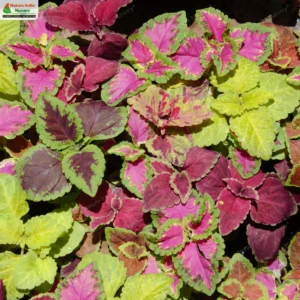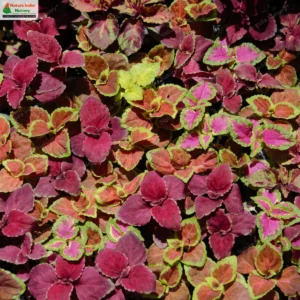Coleus scutellarioides, commonly known as coleus or painted nettle, is a bushy, upright herbaceous perennial or subshrub in the Lamiaceae family, prized for its highly decorative and vibrantly colored foliage. Plants typically grow 60–75 cm tall, but some cultivars may reach up to 1 meter. The stems are usually squarish in cross-section and become semi-woody at the base as they mature. The leaves are ovate to broadly ovate, 1.5–17 cm long, with coarsely crenate or sometimes deeply incised margins, and are arranged oppositely on the stems. Leaf colors and patterns are extremely variable, ranging from green, red, pink, purple, yellow, and orange, often with striking spots, splashes, or veins.
The inflorescence is a terminal raceme or panicle, bearing small, blue to violet, two-lipped flowers. While the flowers are attractive, coleus is primarily cultivated for its foliage. The plant is tender and usually grown as an annual in temperate climates, though it is a perennial in tropical and subtropical regions.
Habitat
Coleus scutellarioides is native to tropical regions of Southeast Asia, Malesia, and northern Australia. It grows naturally in moist, shaded to semi-shaded habitats such as forest edges, riverbanks, scrublands, grasslands, and disturbed areas. The species is widely cultivated and has become naturalized in many tropical and subtropical regions around the world.
Planting and Care
- Light: Prefers partial shade to bright, indirect light; some modern cultivars tolerate full sun.
- Soil: Thrives in moist, well-drained, organically rich soils.
- Watering: Requires regular watering to maintain consistent soil moisture, but avoid waterlogging.
- Temperature: Best grown in warm conditions; sensitive to frost.
- Propagation: Easily propagated by stem cuttings or seeds.
- Maintenance: Pinch back stems to encourage bushiness and remove flower spikes to maintain vibrant foliage color.
- Pests/Diseases: Generally resistant to deer; watch for aphids, mealybugs, and root rot in overly wet conditions.
Additional Information
- Ornamental Use: Widely used in gardens, containers, hanging baskets, and as bedding plants for their colorful foliage.
- Growth Habit: Upright, bushy, or trailing, depending on the cultivar; suitable for groundcover or accent plantings.
- Medicinal Uses: Used in some traditional medicines for unspecified disorders, though primarily valued as an ornamental.
- Environmental Role: Can escape cultivation and become naturalized or weedy in some regions.
- Family: Related to mint, basil, and sage, sharing the characteristic square stems and aromatic foliage.













